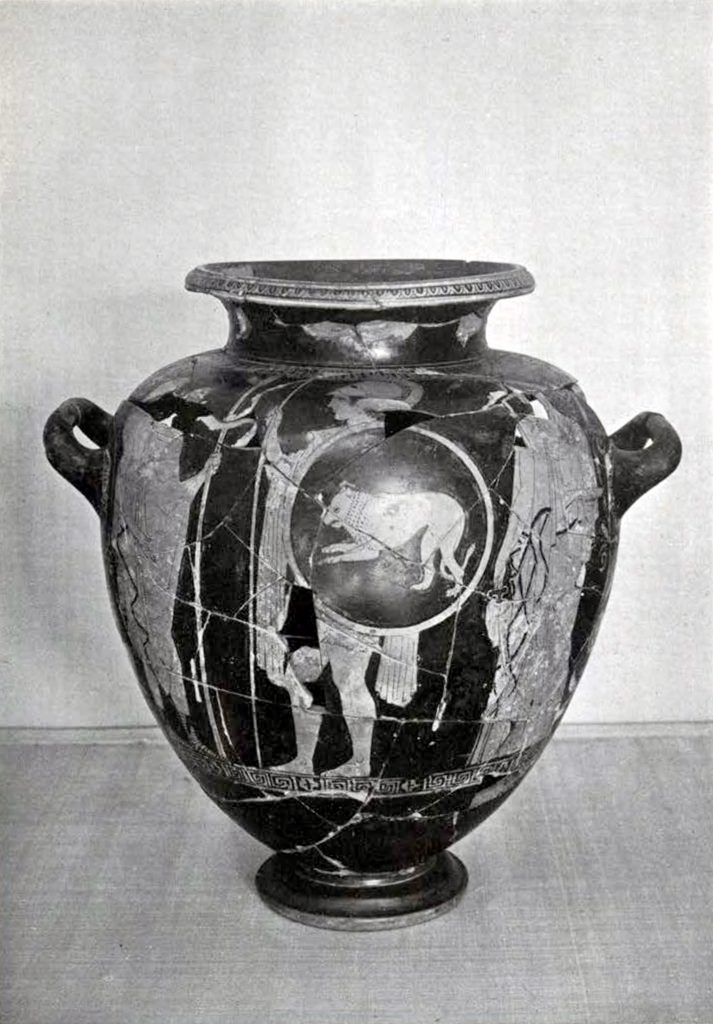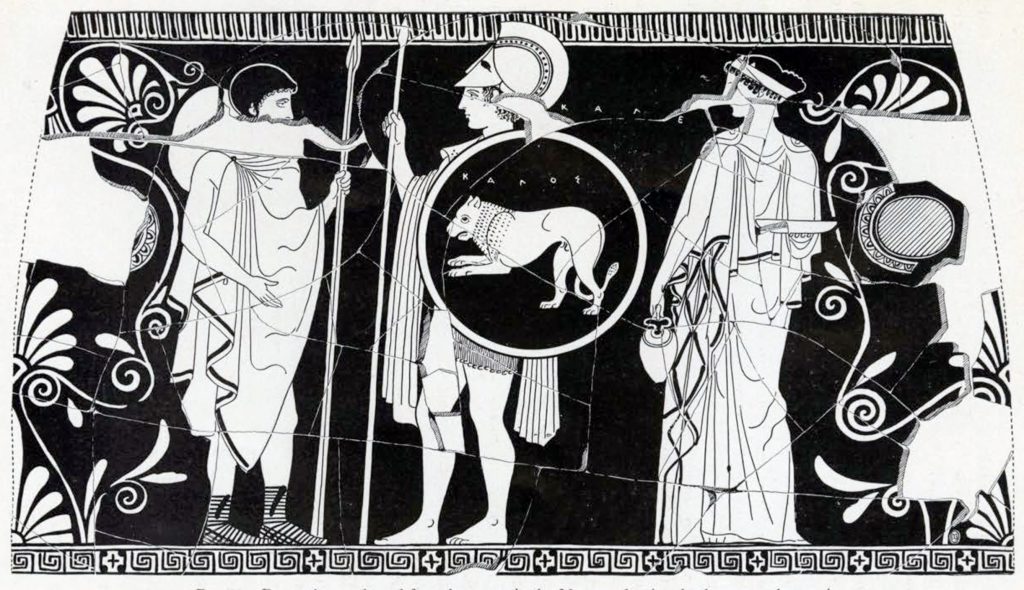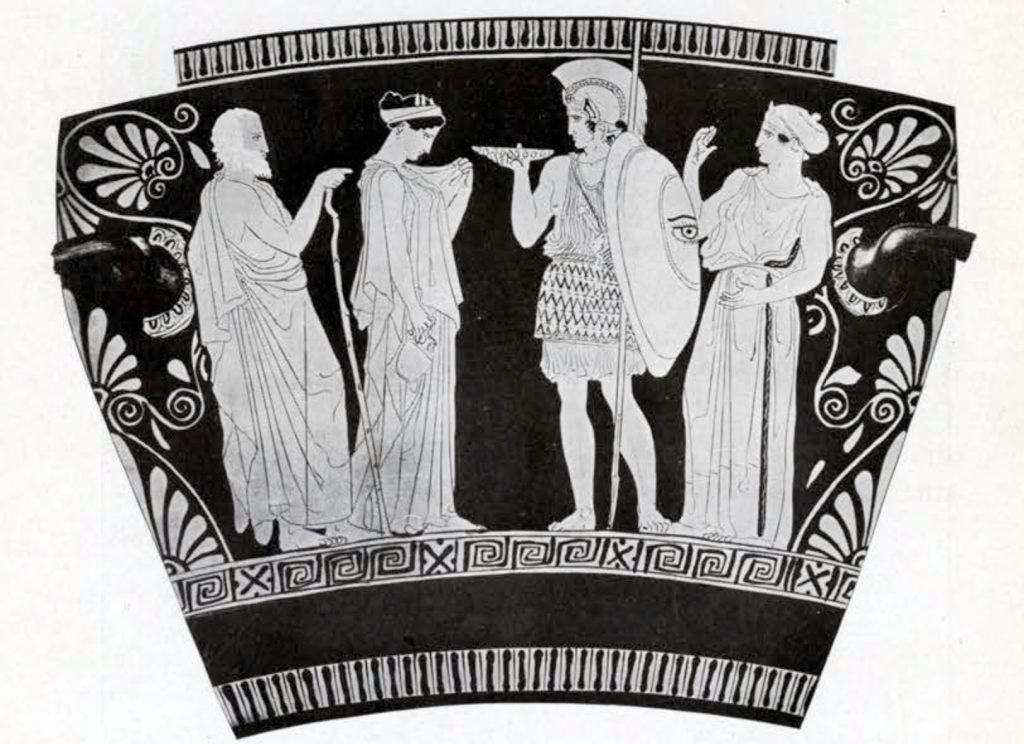Throughout the history of Attic vases, a subject frequently employed by the potters for the painted scenes which decorated their wares was the departure of a warrior. In the sixth century the customary method of treating the scene was to represent the warrior as mounting a chariot in the presence of his family and friends, and since mythological scenes were popular in this period, the subject was often transferred to the realm of legend by the simple expedient of writing the names of well-known heroes beside the various figures of the scene. In the days of Perikles, mythological subjects were in large measure supplanted by scenes from everyday life, and as the technical skill of the potters increased they began to invest their pictures with greater human interest and to prefer such subjects as were fraught with emotional import. None were better adapted for the portrayal of human pathos than the scenes of farewell. The last look exchanged between the departing warrior and his young bride was now the object of the artists’ interest.

Museum Object Number: MS4830
A red-figured stamnos made in this period and decorated with such a scene of farewell was put together in 1911 from fragments purchased at that time of a Philadelphia dealer and though there are regrettable gaps, enough remains to make the scene fairly complete. In the center of the picture stands the departing warrior equipped for battle. He has just turned his back on his young wife who still holds the oinochoe and the bowl from which he has drunk his farewell draught, and poured, it may be, a libation. The girl gazes earnestly at him, but her face, the expression of which was doubtless a chief feature of the scene, is entirely destroyed by a break in the vase. On the left is the comrade or attendant who is apparently waiting to escort the warrior. Two inscriptions, so faint as to be scarcely discernible, are written, the one above the emblem on the warrior’s shield, the other just in front of the head of the maiden. The former, καλός “fair,” refers, of course, to the youth, the other, καλέ, the feminine of the same, to the maiden. It is as if the artist had wished to emphasize, as the late Adolf Furtwaengler remarked of another vase, that he was dealing not with specific individuals, but with the catholic truths of life, the beauty of manhood and young womanhood and the sadness of farewell.
This vase, moreover, possesses a further interest: it not only presents a scene of farewell rendered in the best manner of the Periklean period, but it can definitely be connected with two well-known vases, the one in Munich, the other in St. Petersburg, which are conspicuous among extant Greek vases because they are decorated with precisely the same scene. The extraordinary variety of Greek vase-paintings has often been remarked; even when the subjects are identical and the composition similar, there is still sufficient variety of detail to make them independent works of art. These two vases, however, are so entirely alike as to lead scholars to conclude that they were manufactured in the same workshop on the same day. It is a scene of farewell which is thus repeated. The warrior still holds in his hand the bowl from which he has drunk his farewell draught, and gazes into the eyes. of the maiden who returns his gaze with drooping head and shyly holds before her a corner of her robe. The aged father and mother constitute the marginal figures of the scene.

Museum Object Number: MS4830
Image Number: 183143
That which chiefly concerns us, however, is the resemblance of the vase in this Museum to this pair both as regards style and technique. In the first place it should be noted that all three vases are stamnoi of similar shape, except that the foot of the one now published here for the first time is more elaborate. It has already been remarked that all three are decorated with scenes of farewell in which the last good-bye of the warrior to his wife is the center of interest. Again the reverse of each vase is occupied with three draped figures carelessly rendered in a style totally inferior to that of the obverse scenes. It is noteworthy also that the palmette designs which encircle the handle and fill the spaces intermediate between the obverse and reverse pictures are alike on the two (see Figs. 22 and 23). The palmettes on the vase in St. Petersburg I have not seen. Similarly the meander pattern which frames the scene below is on all three vases irregular as if drawn by an unsteady hand.
Turning now to those resemblances in details of style and technique, there are some which are common to most vases of the Periklean period, such as a fondness for foreshortening hands and feet and for ornamenting the borders of garments with broad bands. But there are also other details which are peculiar to these vases and which betray a common origin. Such is the treatment of the hair, especially of the locks escaping beneath the helmets of the warriors and the fillets of the maidens, which are rendered by wavy lines of thin black. The fillet of the maiden is alike on all three vases. Its folds are indicated by a single diagonal line of black glaze and it is decorated with three tassels or leaf-like ornaments. One of these on the vase in this Museum is destroyed by a crack but the other two are left. A technical peculiarity of all three vases is that in making the preliminary sketch for these pictures, the artist outlined with a fine delicate line only the faces of the figures of the main scene; all other contours were put in with a coarser brush. And lastly the inscriptions are alike on all three vases and are all written with an Ionic lambda and ϵ for η. There can be little doubt therefore that the Museum possesses a stamnos from the same workshop as that which produced the companion vases in Munich and St. Petersburg.
E. H. H.


